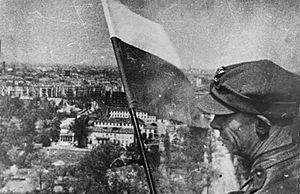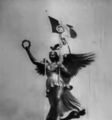Berlin Victory Column facts for kids
The Victory Column is a famous monument in Berlin, Germany. It was designed by Heinrich Strack to celebrate Prussia's victory in the Danish-Prussian War. When it was officially opened on September 2, 1873, Prussia had also won against Austria and France in other wars. Because of these new victories, a large bronze statue of Victoria, the Roman goddess of victory, was added to the top. This statue is 8.3 metres (27 ft) tall and weighs 35 tonnes! Berliners have a special nickname for the statue: Goldelse, which means "Golden Lizzy."
The Victory Column is a very popular place for tourists in Berlin. You can buy a ticket to go up to its viewing platform, which gives you an amazing view of the city.
Contents
History and Design of the Column
How the Column Was Built
The Victory Column stands on a strong base made of shiny red granite. Around the base, there's a hall with pillars and a colorful glass mosaic designed by Anton von Werner.
The column itself was designed by Heinrich Strack. It's made of four big blocks of sandstone. Three of these blocks are decorated with real cannon barrels that were captured from enemies during the three wars it celebrates. A fourth section was added later, in 1938–39, when the monument was moved. This part is decorated with golden garlands. The entire column, including the golden statue on top, is 67 metres (220 ft) tall.
Who Designed It?
Besides Heinrich Strack, who designed the column, and Friedrich Drake who created the Victoria statue, other artists helped too. Anton von Werner designed the beautiful glass mosaic at the base.
The bottom part of the monument has four bronze pictures, called reliefs. These reliefs show scenes from the three wars and the victorious soldiers marching into Berlin. These were created by:
- Moritz Schulz
- Karl Keil
- Alexander Calandrelli
- and Albert Wolff
These bronze pictures were taken off in 1945 but were put back in 1987. This happened thanks to the French president at the time, François Mitterrand, for Berlin's 750th anniversary.
Where the Column Stands Now

The Victory Column wasn't always in its current spot. It first stood in a place called Königsplatz (now known as Platz der Republik). In 1939, the Nazis moved the column to its current location at the Großer Stern (Great Star). This is a large traffic circle on a main road that goes from the old Berliner Stadtschloss (Berlin City Palace) through the Brandenburg Gate to the western parts of the city.
When it was moved, the column was also made taller by another 7.5 meters, reaching its current height of 66.89 meters. The monument survived World War II without much damage. Moving it probably saved it, because its old location was heavily bombed in 1945.
The column is in the middle of a large traffic circle. You can reach it by walking through four tunnels built in 1941. If you're fit, you can climb 281 steps up a spiral staircase inside the column. For a small fee, you can get almost to the top, right under the statue, and enjoy amazing views over the Großer Tiergarten park, including the Soviet War Memorial.
Why the Column is Important
The Victory Column in Berlin looks a lot like other famous victory columns around the world, such as "El Ángel" in Mexico City and the Alexander Column in Saint Petersburg. These columns often have an angel or a victory figure on top.
During the Battle of Berlin in 1945, Soviet soldiers nicknamed the column "the Tall Woman." On May 2, 1945, at the very end of the battle, Polish soldiers fighting with their Soviet allies raised the Polish flag on top of the column.
In 2008, Barack Obama gave a speech at the Victory Column when he was running to become the US president. Some people thought this was a bit controversial because the column celebrates German military victories from the past.
In Popular Culture
The golden statue on top of the column, made in 1873, was featured in the music video for the band U2's song "Stay (Faraway, So Close!)" in 1993.
The column also appears in the 1987 movie Wings of Desire by Wim Wenders. In the film, it's shown as a meeting place for angels.
Images for kids
See also
 In Spanish: Columna de la Victoria para niños
In Spanish: Columna de la Victoria para niños





